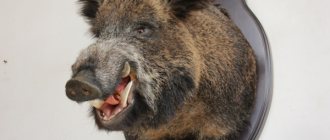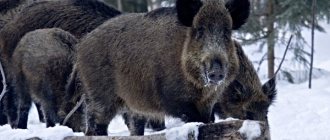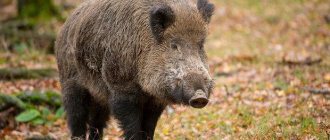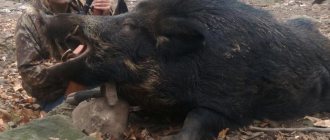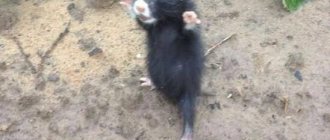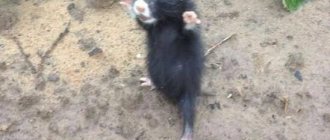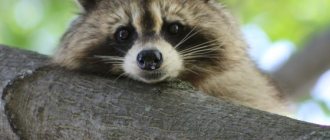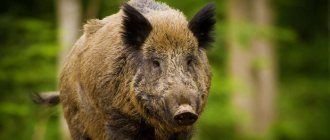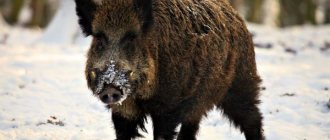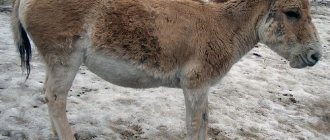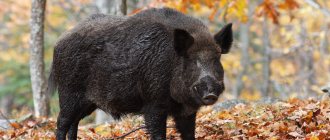Wild boar (boar) is a large mammal from the order Artiodactyla. Scientists consider the historical homeland of the animal to be Southeast Asia. Subsequently, wild boars populated almost the entire territory of Asia and Europe, as well as some regions of Africa.
The forest boar has always been considered a valuable hunting trophy. Uncontrolled killing of animals has led to a sharp decline in the numbers of many species. At the beginning of the 19th century, the complete extermination of wild boars was recorded in some Scandinavian countries, in Libya, Egypt, and the northern part of Japan. On the territory of Russia, a catastrophic reduction in the number of animals was also noted, but the protective measures taken at the end of the last century made it possible to significantly increase the number of wild boars.
General characteristics and description
Wild boars are distinguished by increased endurance and the ability to adapt to various living conditions. They have a thick skin that protects them from enemies, and the accumulated subcutaneous fat layer helps maintain a stable temperature even in severe frosts.
Boars can swim. They are quite agile: if danger approaches, the animal can jump up to 4 m in length and 1.5 m in height. The maximum speed of the boar is 40 km/h, and it can cover distances of 10-15 km without rest.
Animals have a well-developed sense of smell and hearing.
What sounds does a boar make?
What does it look like
The boar genus includes several species with the following common characteristics:
- the body is short with a massive front part and long legs;
- the head is wedge-shaped, the snout is elongated and ends in a penny;
- males have huge fangs, the length of the lower ones can reach 20-25 cm;
- straight tail with a tassel.
The color of the bristles depends on the habitat. As a rule, the color contains gray, brown and brown shades. There are also pure black boars or very light, almost whitish ones.
What is the difference between a wild boar and a domestic pig?
Wild and domestic animals differ in body shape: in wild boars the front part is much wider, while in pigs the body has almost the same thickness along its entire length.
Expressed features of the wild boar’s adaptability to its environment also help to distinguish these two species:
- In wild animals, the bristles are long and thick; before the onset of cold weather, additional fur appears;
- to protect themselves from enemies, males have two pairs of noticeably protruding upper and lower fangs;
- Boars get most of their food in the ground, so their muzzle is more elongated.
At what weight are pigs slaughtered?
Pig farming is profitable due to the fact that it is possible to obtain a large amount of meat products. This is due to the fact that little waste (skin, internal organs, parts of legs) remains. In this regard, when engaging in this type of farming, it is important to know the slaughter weight.
It should be noted that the weight of a live pig and its slaughter weight should not be confused, since these are not identical indicators, and therefore they should be calculated differently. Slaughter weight refers to the weight of meat obtained after cutting the animal carcass. From here the weight of tripe, hide and hooves is subtracted.
Important! It must be remembered that slaughter weight is less than the weight of a living individual.
Pig farmers believe that on average the meat yield should be 60-70 kg with an individual weighing 100 kg, and the fat weight should be 15-25 kg. I would also like to note that a smaller sebaceous layer is obtained in pigs that led an active lifestyle and moved a lot during the fattening period. If the animal led a sedentary lifestyle, this may lead to a decrease in the amount of meat obtained as a result.
Reasons affecting weight:
- The meat characteristics of the breed are one of the most important indicators. Some small breeds of pigs produce a more impressive meat yield than can be observed in large pigs belonging to tall breeds.
- The sex of the animal affects the subsequent yield of meat. A castrated boar will produce more meat than a pig of the same weight.
- Use of mixed feed for feeding (when using feed enriched with useful substances, you can get individuals whose slaughter weight will be greater).
- Proper maintenance of individuals.
When determining the slaughter weight, it is worth remembering that if the individual looks well-fed the day before, then, as a result, more meat can be obtained. This is due to the fact that the weight of bones and internal organs remains unchanged, only meat can grow.
Kinds
Bearded wild pig
The genus of wild boars includes nine living species and one extinct species. Among them, the most interesting are the following:
- Bearded pigs . Found in southeast Asia. They can be recognized by the long light bristles that cover the snout and form a kind of beard.
- Javan pigs . Individuals are medium-sized, with long legs and a very elongated snout. A distinctive feature is the presence of three pairs of warts on the face. This wild boar is listed as an endangered species on the IUCN Red List.
- Dwarf pig . The smallest pig lives in southern Asia. Unlike other species, males live permanently in the herd and guard the queens and cubs. Pygmy pigs are also considered endangered.
Javan wild pig
The most numerous species is the common wild boar. It, in turn, is divided into several groups depending on its habitat:
- western;
- Indian;
- eastern;
- Indonesian.
Each of the listed groups includes from 2 to 7 subspecies.
Big Norma
Among the large boars, the American pig Big Norma or, as she is also called, Big Norma, especially stands out. Farmer Carrie Dart managed to raise a pet of incredible size. Norma reached a weight of about a ton (1200 kilograms), and the length of the boar was 2.5 meters.
After the death of the animal in 2008, an offer was made to make a stuffed animal, to which the owner of the record holder responded with a decisive refusal. He loved his pet and decided to personally bury the pig under a memorial sign.
How many years do wild boars live in the wild?
In their natural habitat, wild boars live 10-11 years, some individuals can live up to 14 years. The lifespan of animals depends on many factors. The main reasons for the premature death of wild boars are:
- attacks by predators (wolves, tigers, leopards, lynxes);
- skirmishes between males for territory or for a female during the mating season;
- lack of sufficient food supply due to drought or severe frosts;
- killing by hunters.
Some diseases can also shorten the lifespan of wild boars. When eating meat from an animal killed during a hunt, you must remember that some of it is dangerous to humans. Such diseases include trichinosis (infection by helminths living in muscle tissue), brucellosis (an infectious disease that affects joints, muscles and blood vessels), metastrongylosis (infection by helminths living in the bronchi and bronchioles) and others.
Wild boars kept in captivity or in protected areas live much longer. The absence of dangers, sufficient food and timely treatment significantly prolong the life of individuals. There are cases where animals lived up to 20 years.
BROWN BEAR
How to determine the age of a boar
Based on the external description of the animal, you can determine which of the three age groups it belongs to:
- piglets (young yearlings) have a short snout, small ears and covered with short bristles, sexual dimorphism is not pronounced, longitudinal stripes are clearly visible on the back;
- in gilts (two-year-olds) there is a noticeable difference between females and males, the front part of the body becomes more massive, the tail, snout and ears lengthen, the body is covered with thicker and longer hair;
- adult individuals have a powerful and short neck, a massive body, which makes the legs appear shorter, a clearly defined mane at the withers, and clearly visible lower fangs.
The age of a sexually mature animal can be more accurately determined by the number and condition of its teeth.
Behavior
Wild boar prefer water-rich, swampy areas, both wooded and overgrown with reeds and bushes. These are social animals that form herds with a matriarchal way of life. Old males usually live alone and join the herd only during the mating season.
Group Behavior
Females form groups of 10-30 individuals: cubs, young and weak males. The largest herds include up to 100 individuals. These groups move over long distances, but only within their own area of 1 to 4 km² and do not migrate.
Movement and orientation
The wild boar moves awkwardly, but quickly, swims well and is able to swim for quite a long time. Vision is poor: the wild boar does not distinguish colors, and will not see a person who stands 15 meters from it. Orients itself using smell, taste and hearing. The boar is cautious, but not cowardly, but if it is irritated, wounded or protecting its cubs, it becomes truly dangerous and aggressive.
Activity time and rest
Since this animal is susceptible to sudden changes in temperature, it rolls around in the mud a lot to protect itself from insects and burns, and to maintain an optimal body temperature. Wild boars are active mainly at dusk; during the day they lie down in dug holes up to 30-40 cm deep. In the evening they come out, swim and go in search of food.
How much does it weigh
Warthog
Adult size varies depending on the wild boar variety, with females typically being smaller than males. Below is the average weight of a boar of some representatives of the genus:
| View | Weight | Height (height at withers) |
| Warthog (African wild boar) | Up to 250 kg | 90 cm |
| Indian wild boar | 140 kg | 80 cm |
| Visayas warty pig | Up to 70 kg | 60-65 cm |
| Ussuri boar | Up to 300 kg | 120 cm |
| bearded pig | Up to 150 kg | 75-85 |
| Pygmy pig | Up to 4.5 kg | 20-25 cm |
The largest boar killed during the hunt weighed about 500 kg. The trophy belongs to a hunter from Alabama, USA.
How to measure the weight of an adult pig
Adults should be considered pigs that have completed their growth, that is, animals older than 9 months.
The following methods have been developed for measuring live weight without weighing:
Measuring by table
To calculate the live weight of a pig, use a measuring tape. It is most convenient to use a one and a half meter tailor's tape. The procedure is carried out in the morning, on an empty stomach.
Make sure the animal stands upright. To do this, the assistant offers her a treat from his hand. First, determine the length of the body. The tape is applied to the back of the head and pulled to the base of the tail.
The next stage is determining the weight according to the table. The mass of the animal is determined at the intersection of rows and columns.
If the body length is 102 cm, and the chest circumference behind the shoulder blades is 120 cm, the pig’s weight is 123 kg. The error in determining mass varies within 10%.
Calculation by formula
There is a special formula:
- B=0.99*D+1.54*O-150;
where: B is the weight of the animal, D is the length of the body, O is the girth behind the shoulder blades.
The result of the calculation is 133 kg. Tabular and calculated results vary widely. Table data was developed by comparing measurements with weighing results. Therefore, it is better to use them rather than formulas.
Where does it live?
Indian
The historical range extends to Europe, the Middle East, India, most of the Asian continent, and northern Africa. Wild boars, which are found in America and Australia, are the feral ancestors of domestic pigs brought there by colonists.
Where does he live?
The traditional habitat of the wild boar is deciduous and mixed forests. The crowns of trees and shrubs that descend to the ground provide shelter for the animal and also provide food. You can meet a wild boar near rivers and swamps, where it hides in reed thickets. Wild boars also live in mountainous regions.
Area
The range of residence of wild boar is quite wide:
- Europe,
- India,
- Near East,
- East and Southeast Asia,
- Asia Minor,
- Northern regions of Africa,
- Some places in Siberia, in the south of the Irkutsk region, Krasnoyarsk Territory, in some forests in the Moscow region,
- Eastern part of America,
- Somewhere in Australia.
The wild boar prefers to live in wooded areas. In search of food, it often enters a highland meadow with an altitude of no more than 3300 m. In some places it actively populates deciduous and fruit forests.
Wild boar was specially brought to the United States for hunting purposes. In Australia, wild boars are actually feral domestic pigs. They lead the same lifestyle as wild pigs from Europe, and are not considered a separate species of wild boar.
In many places the boar was exterminated. In England, almost all wild boars were killed in the 13th century, in Denmark - in the 19th. In Russia, the number of wild boars had seriously decreased by the 30s. In the 50s, people began working to restore the wild boar population. Now they are found even in populated areas such as, for example, Losiny Island near Moscow .
Habits
Wild boars lead a predominantly gregarious lifestyle. They gather in herds that include several females and their young. Adult males prefer to live separately and join groups only during the rut. When two loppers join the herd, skirmishes occur between them for the right to cover the females.
During the daytime, the animals hide in a den made of branches and grass. The shelter is usually located in thickets of bushes or tall grass. Wild boars overwinter in pits: they tear up the snow, dig out last year's leaves and lay down on them.
Despite its threatening appearance, the wild boar is a cautious animal: it moves carefully through the forest, and upon hearing loud sounds or foreign odors, it immediately hides in a shelter and remains there, waiting out danger.
FOX
Natural enemies
In addition to people, wild boar, mainly young animals, are threatened by wolves and lynxes, and in Asia by leopards and tigers, which occasionally attack adult males. Large snakes and birds of prey can also attack baby piglets. In general, the population is stable and is not under threat of extinction or destruction.
What does it eat?
Representatives of the boar genus are classified as omnivores. Their diet may vary depending on the time of year and habitat, while most of the food is obtained from the soil.
In spring, when the ground becomes soft, wild boars eat plant rhizomes, preferring juicy tubers and bulbs. They can also feed on last year's acorns and other fruits and seeds of plants preserved in the ground. After the grass cover appears, the animals eat young shoots of sedge, nettle, and marigold.
In summer, when the vegetation becomes dry and tough, wild boars again switch to rhizomes. Tearing up the ground in search of roots and tubers, they happily eat worms and insect larvae found in the ground.
At the end of summer and autumn, the main part of the diet consists of nuts, berries, fruits of bushes and trees. In winter, wild boars' diet consists of rhizomes and animal food (water rats, mice and other rodents). With a lack of food supply, they have to feed on dry leaves, moss, bark and branches of bushes.
It is known that wild boars eat spawning fish swimming in shallow waters and destroy bird nests, eating eggs and chicks.
Nutrition
What does a wild boar eat? Being an omnivore and having a formidable appearance, the wild boar still prefers various plant foods: acorns, root vegetables, berries and mushrooms. In winter, during a shortage of plant food and, moreover, cold weather, wild boars switch to a more satisfying diet; they can eat carrion, bird eggs, and larvae found on the ground and under the bark of some trees. By eating these larvae, which are often pests of trees, wild boars bring great benefits to the forest.
An adult boar eats up to 6 kg of food per day, and they also need a large amount of water. When coming to a river or lake to drink, wild boars are not averse to eating fish.
Reproduction
Puberty in male wild boars occurs in the 4-5th year of life, females are ready to breed in the second year. The rutting period occurs in the winter months. Males, using tracks and marks, find a group of females with grown cubs and live in the herd for some time. Usually the cleaver covers all mature females, after which it leaves the group again.
A female wild boar bears offspring for 4 months. Feeling the approach of childbirth, she finds a secluded place in the forest and prepares a nest there from grass and leaves. A litter usually contains 8-10 piglets, weighing up to 1 kg.
Wild boar cubs feed on their mother's milk for up to 3 months and continue to stay with her for up to 7 months. Usually only half of the individuals from the litter survive, the rest become victims of predators or cannot tolerate harsh living conditions.
Adviсe
Let's look at some recommendations for raising pigs for meat that help get maximum results:
- During cultivation, it is worth resorting to intensive and non-intensive fattening. At the same time, farm managers use kitchen waste to feed animals, and the share of compound feed used is small. This makes it possible to increase meat gain, since such a distribution of the pigs’ diet will allow them to reach a weight of 100 kg by 10-12 months. This feeding option requires minimal costs, however, the meat yield at slaughter will also be minimal.
- Fattening begins when the individual reaches a weight of 30 kg, which will happen approximately in the third month of the piglet’s life. It lasts for 4-5 months, only at times it lasts a little longer. During fattening, a piglet is able to gain up to 700 g per day. This method allows you to gain weight from 100 to 130 kg by the time the pig reaches the age of 8-9 months.
- Feeding for young piglets should be introduced immediately after birth: first the sow feeds them with her milk, and then the piglets are fed.
- Animals should be kept in spacious rooms; the presence of lighting also has a positive effect.
Important! To obtain soft and tasty meat, you need to balance the animals' diet. It should include a lot of greens. It can be weeds, nettles, carrot and beet tops.
Thus, it is possible to raise healthy pigs and ultimately obtain a high-quality product in a personal household. The main thing is to take a responsible approach to the care and raising of animals.
Why is it dangerous for humans?
Boars are not known for their aggressive behavior and, if possible, try to avoid meeting people. Often cases of animal attacks are provoked by the person himself. In spring and early summer, the cause of aggression may be the protection of the cubs by the female. During this period, piglets become more independent and move away from their mother in search of food. If you see a piglet in the forest, you should not approach it, much less pick it up, otherwise you may encounter a dangerous enemy - an angry female. Guided by maternal instinct, she becomes aggressive and ferocious, and will protect her offspring, regardless of the wounds inflicted on her.
A meeting with a wild boar that has been injured during a hunt is also dangerous. The beast is distinguished by its endurance and strength, so situations often occur when it cannot be killed on the first try. The cleaver boar is especially dangerous, capable of inflicting quite serious and even fatal wounds with its fangs.
If you find yourself face to face with an angry animal, you should not turn your back to it and run away. You can escape from a wild boar in a tree.
NOBLE DEER
Interesting Facts
- Boars are among the ten most intelligent animals; they are very smart and observant.
- Boars' sense of smell is better developed than that of dogs: they can easily find food in the ground by smell. Noticing this feature, people taught wild boars to look for truffles - the most expensive mushrooms in the world, growing at a depth of 30 cm and below.
- Boars constantly sharpen their upper and lower tusks by rubbing them against each other.
- The wild hog is one of the first domesticated animals. It is known that the ancestors of modern pigs were domesticated by humans more than 10 thousand years ago in Asia.
- Boars and pigs are unreasonably called dirty: these animals are very clean, and traditional water and mud baths are just a way to get rid of parasites and cleanse stubble.
